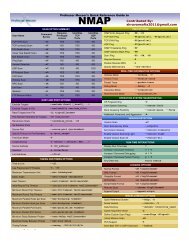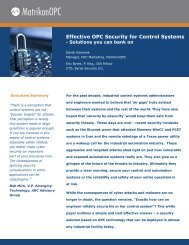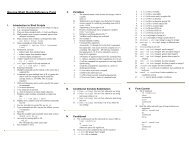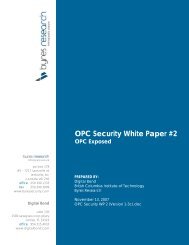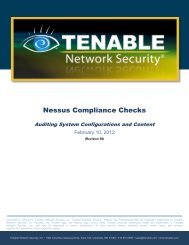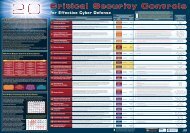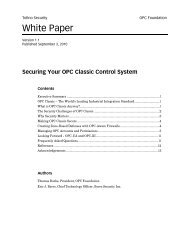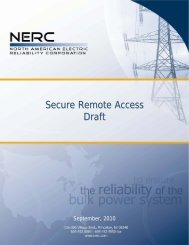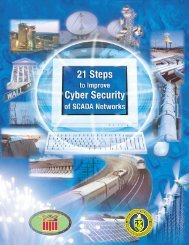Mapping between NIST 800-53 and ISO/IEC 27001 - SCADAhacker
Mapping between NIST 800-53 and ISO/IEC 27001 - SCADAhacker
Mapping between NIST 800-53 and ISO/IEC 27001 - SCADAhacker
Create successful ePaper yourself
Turn your PDF publications into a flip-book with our unique Google optimized e-Paper software.
<strong>NIST</strong> Special Publication <strong>800</strong>-<strong>53</strong>Revision 3Recommended Security Controlsfor Federal Information Systems<strong>and</strong> OrganizationsJOINT TASK FORCETRANSFORMATION INITIATIVEI N F O R M A T I O NS E C U R I T YComputer Security DivisionInformation Technology LaboratoryNational Institute of St<strong>and</strong>ards <strong>and</strong> TechnologyGaithersburg, MD 20899-8930August 2009INCLUDES UPDATES AS OF 05-01-2010U.S. Department of CommerceGary Locke, SecretaryNational Institute of St<strong>and</strong>ards <strong>and</strong> TechnologyPatrick D. Gallagher, Deputy Director
Special Publication <strong>800</strong>-<strong>53</strong> Recommended Security Controls for Federal Information Systems <strong>and</strong> Organizations________________________________________________________________________________________________APPENDIX HINTERNATIONAL INFORMATION SECURITY STANDARDSSECURITY CONTROL MAPPINGS FOR <strong>ISO</strong>/<strong>IEC</strong> <strong>27001</strong>The mapping tables in this appendix provide organizations with a general indication ofsecurity control coverage with respect to <strong>ISO</strong>/<strong>IEC</strong> <strong>27001</strong>, Information technology–Securitytechniques–Information security management systems–Requirements. 76 <strong>ISO</strong>/<strong>IEC</strong><strong>27001</strong> applies to all types of organizations (e.g., commercial, government) <strong>and</strong> specifiesrequirements for establishing, implementing, operating, monitoring, reviewing, maintaining, <strong>and</strong>improving a documented information security management system (ISMS) within the context ofthe organization’s overall business risks. While the risk management approach established by<strong>NIST</strong> originally focused on managing risk from information systems (as required by FISMA <strong>and</strong>described in <strong>NIST</strong> Special Publication <strong>800</strong>-39), the approach is being exp<strong>and</strong>ed to include riskmanagement at the organizational level. A forthcoming version of <strong>NIST</strong> Special Publication <strong>800</strong>-39 will incorporate <strong>ISO</strong>/<strong>IEC</strong> <strong>27001</strong> to manage organizational information security risk throughthe establishment of an ISMS. Since <strong>NIST</strong>’s mission includes the adoption of international <strong>and</strong>national st<strong>and</strong>ards where appropriate, <strong>NIST</strong> intends to pursue convergence to reduce the burdenon organizations that must conform to both sets of st<strong>and</strong>ards. The convergence initiative will becarried out in three phases. Phase I, the subject of this appendix, provides a two-way mapping<strong>between</strong> the security controls in <strong>NIST</strong> Special Publication <strong>800</strong>-<strong>53</strong> <strong>and</strong> the controls in <strong>ISO</strong>/<strong>IEC</strong><strong>27001</strong> (Annex A). Phase II will provide a two-way mapping <strong>between</strong> the organization-level riskmanagement concepts in <strong>NIST</strong> Special Publication <strong>800</strong>-39 (forthcoming version) <strong>and</strong> generalrequirements in <strong>ISO</strong>/<strong>IEC</strong> <strong>27001</strong>. Phase III will use the results from Phase I <strong>and</strong> II to fullyintegrate <strong>ISO</strong>/<strong>IEC</strong> <strong>27001</strong> into <strong>NIST</strong>’s risk management approach such that an organization thatcomplies with <strong>NIST</strong> st<strong>and</strong>ards <strong>and</strong> guidelines can also comply with <strong>ISO</strong>/<strong>IEC</strong> <strong>27001</strong> (subject toappropriate assessment requirements for <strong>ISO</strong>/<strong>IEC</strong> <strong>27001</strong> certification).Table H-1 provides a forward mapping from the security controls in <strong>NIST</strong> Special Publication<strong>800</strong>-<strong>53</strong> to the controls in <strong>ISO</strong>/<strong>IEC</strong> <strong>27001</strong> (Annex A). The mappings are created by using theprimary security topic identified in each of the Special Publication <strong>800</strong>-<strong>53</strong> security controls <strong>and</strong>associated control enhancements (if any) <strong>and</strong> searching for a similar security topic in <strong>ISO</strong>/<strong>IEC</strong><strong>27001</strong> (Annex A). Security controls with similar functional meaning are included in the mappingtable. For example, Special Publication <strong>800</strong>-<strong>53</strong> contingency planning <strong>and</strong> <strong>ISO</strong>/<strong>IEC</strong> <strong>27001</strong>(Annex A) business continuity were deemed to have similar, but not the same, functionality. Insome cases, similar topics are addressed in the security control sets but provide a differentcontext, perspective, or scope. For example, Special Publication <strong>800</strong>-<strong>53</strong> addresses informationflow control broadly in terms of approved authorizations for controlling access <strong>between</strong> source<strong>and</strong> destination objects, whereas <strong>ISO</strong>/<strong>IEC</strong> <strong>27001</strong> (Annex A) addresses the information flow morenarrowly as it applies to interconnected network domains. Table H-2 provides a reverse mappingfrom the security controls in <strong>ISO</strong>/<strong>IEC</strong> <strong>27001</strong> (Annex A) to the security controls in SpecialPublication <strong>800</strong>-<strong>53</strong>. 7776 <strong>ISO</strong>/<strong>IEC</strong> <strong>27001</strong> was published in October 2005 by the International Organization for St<strong>and</strong>ardization (<strong>ISO</strong>) <strong>and</strong> theInternational Electrotechnical Commission (<strong>IEC</strong>).77 The use of the term XX-1 controls in mapping Table H-2 refers to the set of security controls represented by the firstcontrol in each family in <strong>NIST</strong> Special Publication <strong>800</strong>-<strong>53</strong>, where XX is a placeholder for the two-letter familyidentifier. These security controls primarily focus on policies <strong>and</strong> procedures for each topic area addressed by therespective security control family.APPENDIX H PAGE H-1
Special Publication <strong>800</strong>-<strong>53</strong> Recommended Security Controls for Federal Information Systems <strong>and</strong> Organizations________________________________________________________________________________________________Organizations are encouraged to use the mapping tables as a starting point for conducting furtheranalyses <strong>and</strong> interpretation of the extent of compliance with <strong>ISO</strong>/<strong>IEC</strong> <strong>27001</strong> from compliancewith the <strong>NIST</strong> security st<strong>and</strong>ards <strong>and</strong> guidelines <strong>and</strong> visa versa. Organizations that use thesecurity controls in Special Publication <strong>800</strong>-<strong>53</strong> as an extension to the security controls in AnnexA in their <strong>ISO</strong>/<strong>IEC</strong> <strong>27001</strong> implementations will have a higher probability of complying with<strong>NIST</strong> security st<strong>and</strong>ards <strong>and</strong> guidelines than those organizations that use only Annex A.TABLE H-1: MAPPING <strong>NIST</strong> SP <strong>800</strong>-<strong>53</strong> TO <strong>ISO</strong>/<strong>IEC</strong> <strong>27001</strong> (ANNEX A)<strong>NIST</strong> SP <strong>800</strong>-<strong>53</strong> CONTROLS<strong>ISO</strong>/<strong>IEC</strong> <strong>27001</strong> (Annex A) CONTROLSAC-1 Access Control Policy <strong>and</strong> Procedures A5.1.1, A5.1.2, A.6.1.1, A.6.1.3, A.8.1.1, A10.1.1, A.10.8.1,A.11.1.1, A.11.2.1, A11.2.2, A11.4.1, A.11.7.1, A.11.7.2,A.15.1.1, A.15.2.1AC-2 Account Management A.8.3.3, A.11.2.1, A.11.2.2, A.11.2.4, A15.2.1AC-3 Access Enforcement A.10.8.1 A.11.4.4, A.11.4.6, A.11.5.4, A.11.6.1, A.12.4.2AC-4 Information Flow Enforcement A.10.6.1, A.10.8.1, A.11.4.5, A.11.4.7, A.11.7.2, A.12.4.2,A.12.5.4AC-5 Separation of Duties A.6.1.3, A.8.1.1, A.10.1.3, A.11.1.1, A.11.4.1AC-6 Least Privilege A.6.1.3, A.8.1.1, A.11.1.1, A.11.2.2, A.11.4.1, A.11.4.4,A.11.4.6, A.11.5.4, A.11.6.1, A.12.4.3AC-7 Unsuccessful Login Attempts A.11.5.1AC-8 System Use Notification A.6.2.2, A.8.1.1, A.11.5.1, A.15.1.5AC-9 Previous Logon (Access) Notification A.11.5.1AC-10 Concurrent Session Control A.11.5.1AC-11 Session Lock A.11.3.2, A.11.3.3, A.11.5.5AC-12 Withdrawn ---AC-13 Withdrawn ---AC-14 Permitted Actions without Identification or A.11.6.1AuthenticationAC-15 Withdrawn ---AC-16 Security Attributes A.7.2.2AC-17 Remote Access A.10.6.1, A.10.8.1, A.11.1.1, A.11.4.1, A.11.4.2, A.11.4.4,A.11.4.6, A.11.4.7, A.11.7.1, A.11.7.2AC-18 Wireless Access A.10.6.1, A.10.8.1, A.11.1.1, A.11.4.1, A.11.4.2, A.11.4.4,A.11.4.6, A.11.4.7, A.11.7.1, A.11.7.2AC-19 Access Control for Mobile Devices A.10.4.1, A.11.1.1, A.11.4.3, A.11.7.1AC-20 Use of External Information Systems A.7.1.3, A.8.1.1, A.8.1.3, A.10.6.1, A.10.8.1, A.11.4.1,A.11.4.2AC-21 User-Based Collaboration <strong>and</strong> Information A.11.2.1, A.11.2.2SharingAC-22 Publicly Accessible Content NoneAT-1 Security Awareness <strong>and</strong> Training Policy<strong>and</strong> ProceduresA.5.1.1, A.5.1.2, A.6.1.1, A.6.1.3, A.8.1.1, A.10.1.1, A.15.1.1,A.15.2.1AT-2 Security Awareness A.6.2.2, A.8.1.1, A.8.2.2, A.9.1.5, A.10.4.1AT-3 Security Training A.8.1.1, A.8.2.2, A.9.1.5AT-4 Security Training Records NoneAT-5 Contacts with Security Groups <strong>and</strong> A.6.1.7AssociationsAU-1 Audit <strong>and</strong> Accountability Policy <strong>and</strong>ProceduresA.5.1.1, A.5.1.2, A.6.1.1, A.6.1.3, A.8.1.1, A.10.1.1, A.10.10.2,A.15.1.1, A.15.2.1, A.15.3.1AU-2 Auditable Events A.10.10.1, A.10.10.4, A.10.10.5, A.15.3.1AU-3 Content of Audit Records A.10.10.1AU-4 Audit Storage Capacity A.10.10.1, A.10.3.1AU-5 Response to Audit Processing Failures A.10.3.1, A.10.10.1AU-6 Audit Review, Analysis, <strong>and</strong> Reporting A.10.10.2, A.10.10.5, A.13.1.1, A.15.1.5AU-7 Audit Reduction <strong>and</strong> Report Generation A.10.10.2AU-8 Time Stamps A.10.10.1, A.10.10.6AU-9 Protection of Audit Information A.10.10.3, A.13.2.3, A.15.1.3, A.15.3.2AU-10 Non-repudiation A.10.9.1, A.12.2.3AU-11 Audit Record Retention A.10.10.1, A.10.10.2, A.15.1.3APPENDIX H PAGE H-2
Special Publication <strong>800</strong>-<strong>53</strong> Recommended Security Controls for Federal Information Systems <strong>and</strong> Organizations________________________________________________________________________________________________<strong>NIST</strong> SP <strong>800</strong>-<strong>53</strong> CONTROLS<strong>ISO</strong>/<strong>IEC</strong> <strong>27001</strong> (Annex A) CONTROLSAU-12 Audit Generation A.10.10.1, A.10.10.4, A.10.10.5AU-13 Monitoring for Information Disclosure NoneAU-14 Session Audit NoneCA-1 Security Assessment <strong>and</strong> AuthorizationPolicies <strong>and</strong> ProceduresA.5.1.1, A.5.1.2, A.6.1.1, A.6.1.3 A.6.1.4, A.8.1.1, A.10.1.1,A.15.1.1, A.15.2.1CA-2 Security Assessments A.6.1.8, A.10.3.2, A.15.2.1, A.15.2.2CA-3 Information System Connections A.6.2.1, A.6.2.3, A.10.6.1, A.10.8.1, A.10.8.2, A.10.8.5,A.11.4.2CA-4 Withdrawn ---CA-5 Plan of Action <strong>and</strong> Milestones NoneCA-6 Security Authorization A.6.1.4, A.10.3.2CA-7 Continuous Monitoring A.6.1.8, A.15.2.1, A.15.2.2CM-1 Configuration Management Policy <strong>and</strong>ProceduresA.5.1.1, A.5.1.2, A.6.1.1, A.6.1.3, A.8.1.1, A.10.1.1, A.10.1.2,A.12.4.1, A.12.5.1, A.15.1.1, A.15.2.1CM-2 Baseline Configuration A.12.4.1, A.10.1.4CM-3 Configuration Change Control A.10.1.1, A.10.1.2, A.10.3.2, A.12.4.1, A.12.5.1, A.12.5.2,A.12.5.3CM-4 Security Impact Analysis A.10.1.2, A.10.3.2, A.12.4.1, A.12.5.2, A.12.5.3CM-5 Access Restrictions for Change A.10.1.2, A.11.1.1, A.11.6.1, A.12.4.1, A.12.4.3, A.12.5.3CM-6 Configuration Settings NoneCM-7 Least Functionality NoneCM-8 Information System Component Inventory A.7.1.1, A.7.1.2CM-9 Configuration Management Plan A.6.1.3. A.7.1.1, A.7.1.2, A.8.1.1, A.10.1.1, A.10.1.2, A.10.3.2,A.12.4.1, A.12.4.3, A.12.5.1, A.12.5.2, A.12.5.3CP-1 Contingency Planning Policy <strong>and</strong>ProceduresA.5.1.1, A.5.1.2, A.6.1.1, A.6.1.3, A.8.1.1, A.9.1.4, A.10.1.1,A.10.1.2, A.14.1.1, A.14.1.3, A.15.1.1, A.15.2.1CP-2 Contingency Plan A.6.1.2, A.9.1.4, A.10.3.1, A.14.1.1, A.14.1.2, A.14.1.3,A.14.1.4, A.14.1.5CP-3 Contingency Training A.8.2.2, A.9.1.4, A.14.1.3CP-4 Contingency Plan Testing <strong>and</strong> Exercises A.6.1.2, A.9.1.4, A.14.1.1, A.14.1.3, A.14.1.4, A.14.1.5CP-5 Withdrawn ---CP-6 Alternate Storage Site A.9.1.4, A.14.1.3CP-7 Alternate Processing Site A.9.1.4, A.14.1.3CP-8 Telecommunications Services A.9.1.4, A.10.6.1, A.14.1.3CP-9 Information System Backup A.9.1.4, A.10.5.1, A.14.1.3, A.15.1.3CP-10 Information System Recovery <strong>and</strong>A.9.1.4, A.14.1.3ReconstitutionIA-1 Identification <strong>and</strong> Authentication Policy<strong>and</strong> ProceduresA.5.1.1, A.5.1.2, A.6.1.1, A.6.1.3, A.8.1.1, A.10.1.1, A.11.2.1,A.15.1.1, A.15.2.1IA-2 Identification <strong>and</strong> AuthenticationA.11.3.2, A.11.5.1, A.11.5.2, A.11.5.3(Organizational Users)IA-3 Device Identification <strong>and</strong> Authentication A.11.4.3IA-4 Identifier Management A.11.5.2IA-5 Authenticator Management A.11.2.1, A.11.2.3, A.11.3.1, A.11.5.2, A.11.5.3IA-6 Authenticator Feedback A.11.5.1IA-7 Cryptographic Module Authentication A.12.3.1, A.15.1.1, A.15.1.6, A.15.2.1IA-8 Identification <strong>and</strong> Authentication (Non- A.10.9.1, A.11.4.2, A.11.5.1, A.11.5.2Organizational Users)IR-1 Incident Response Policy <strong>and</strong> Procedures A.5.1.1, A.5.1.2, A.6.1.1, A.6.1.3, A.8.1.1, A.10.1.1, A.13.1.1,A.13.2.1, A.15.1.1, A.15.2.1IR-2 Incident Response Training A.8.2.2IR-3 Incident Response Testing <strong>and</strong> Exercises NoneIR-4 Incident H<strong>and</strong>ling A.6.1.2, A.13.2.2, A.13.2.3IR-5 Incident Monitoring NoneIR-6 Incident Reporting A.6.1.6, A.13.1.1IR-7 Incident Response Assistance NoneIR-8 Incident Response Plan NoneMA-1 System Maintenance Policy <strong>and</strong>ProceduresA.5.1.1, A.5.1.2, A.6.1.1, A.6.1.3, A.8.1.1, A.9.2.4, A.10.1.1,A.15.1.1, A.15.2.1MA-2 Controlled Maintenance A.9.2.4APPENDIX H PAGE H-3
Special Publication <strong>800</strong>-<strong>53</strong> Recommended Security Controls for Federal Information Systems <strong>and</strong> Organizations________________________________________________________________________________________________<strong>NIST</strong> SP <strong>800</strong>-<strong>53</strong> CONTROLS<strong>ISO</strong>/<strong>IEC</strong> <strong>27001</strong> (Annex A) CONTROLSMA-3 Maintenance Tools A.9.2.4, A.11.4.4MA-4 Non-Local Maintenance A.9.2.4, A.11.4.4MA-5 Maintenance Personnel A.9.2.4, A.12.4.3MA-6 Timely Maintenance A.9.2.4MP-1 Media Protection Policy <strong>and</strong> Procedures A.5.1.1, A.5.1.2, A.6.1.1, A.6.1.3, A.8.1.1, A.10.1.1, A.10.7.1,A.10.7.2, A.10.7.3, A.11.1.1, A.15.1.1, A.15.1.3, A.15.2.1MP-2 Media Access A.7.2.2, A.10.7.1, A.10.7.3MP-3 Media Marking A.7.2.2, A.10.7.1, A.10.7.3MP-4 Media Storage A.10.7.1, A.10.7.3, A.10.7.4, A.15.1.3MP-5 Media Transport A.9.2.5, A.9.2.7, A.10.7.1, A.10.7.3, A.10.8.3MP-6 Media Sanitization A.9.2.6, A.10.7.1, A.10.7.2, A.10.7.3PE-1Physical <strong>and</strong> Environmental ProtectionPolicy <strong>and</strong> ProceduresA.5.1.1, A.5.1.2, A.6.1.1, A.6.1.3, A.8.1.1, A.9.1.4, A.9.2.1,A.9.2.2, A.10.1.1, A.11.1.1, A.11.2.1, A.11.2.2, A.15.1.1,A.15.2.1PE-2 Physical Access Authorizations A.9.1.5, A.11.2.1, A.11.2.2, A.11.2.4PE-3 Physical Access Control A.9.1.1, A.9.1.2, A.9.1.3, A.9.1.5, A.9.1.6, A.11.3.2, A.11.4.4PE-4 Access Control for Transmission Medium A.9.1.3, A.9.1.5, A.9.2.3PE-5 Access Control for Output Devices A.9.1.2, A.9.1.3, A.10.6.1, A.11.3.2PE-6 Monitoring Physical Access A.9.1.2, A.9.1.5, A.10.10.2PE-7 Visitor Control A.9.1.2, A.9.1.5, A.9.1.6PE-8 Access Records A.9.1.5, A.10.10.2, A.15.2.1PE-9 Power Equipment <strong>and</strong> Power Cabling A.9.1.4, A.9.2.2, A.9.2.3PE-10 Emergency Shutoff A.9.1.4PE-11 Emergency Power A.9.1.4, A.9.2.2PE-12 Emergency Lighting A.9.2.2PE-13 Fire Protection A.9.1.4PE-14 Temperature <strong>and</strong> Humidity Controls A.9.2.2PE-15 Water Damage Protection A.9.1.4PE-16 Delivery <strong>and</strong> Removal A.9.1.6, A.9.2.7, A.10.7.1PE-17 Alternate Work Site A.9.2.5, A.11.7.2PE-18 Location of Information SystemA.9.2.1, A.11.3.2ComponentsPE-19 Information Leakage A.12.5.4PL-1 Security Planning Policy <strong>and</strong> Procedures A.5.1.1, A.5.1.2, A.6.1.1, A.6.1.2, A.6.1.3, A.8.1.1, A.10.1.1,A.15.1.1, A.15.2.1PL-2 System Security Plan NonePL-3 Withdrawn ---PL-4 Rules of Behavior A.6.1.5, A.6.2.2, A.7.1.3. A.8.1.1, A.8.1.3, A.8.2.1, A.9.1.5,A.10.8.1, A.11.7.1, A.11.7.2, A.12.4.1, A.13.1.2, A.15.1.5PL-5 Privacy Impact Assessment A.15.1.4PL-6 Security-Related Activity Planning A.6.1.2, A.15.3.1PS-1 Personnel Security Policy <strong>and</strong> Procedures A.5.1.1, A.5.1.2, A.6.1.1, A.6.1.3, A.8.1.1, A.10.1.1, A.15.1.1,A.15.2.1PS-2 Position Categorization A.8.1.1PS-3 Personnel Screening A.8.1.2PS-4 Personnel Termination A.8.3.1, A.8.3.2, A.8.3.3PS-5 Personnel Transfer A.8.3.1, A.8.3.2, A.8.3.3PS-6 Access Agreements A.6.1.5, A.8.1.1, A.8.1.3, A.8.2.1, A.9.1.5, A.10.8.1, A.11.7.1,A.11.7.2, A.15.1.5PS-7 Third-Party Personnel Security A.6.2.3, A.8.1.1, A.8.2.1, A.8.1.3PS-8 Personnel Sanctions A.8.2.3, A.15.1.5RA-1 Risk Assessment Policy <strong>and</strong> Procedures A.5.1.1, A.5.1.2, A.6.1.1, A.6.1.3, A.8.1.1, A.10.1.1, A.14.1.2,A.15.1.1, A.15.2.1RA-2 Security Categorization A.7.2.1, A.14.1.2RA-3 Risk Assessment A.6.2.1, A.10.2.3, A.12.6.1, A.14.1.2RA-4 Withdrawn ---RA-5 Vulnerability Scanning A.12.6.1, A.15.2.2SA-1 System <strong>and</strong> Services Acquisition Policy<strong>and</strong> ProceduresA.5.1.1, A.5.1.2, A.6.1.1, A.6.1.3, A.6.2.1, A.8.1.1, A.10.1.1,A.12.1.1, A.12.5.5, A.15.1.1, A.15.2.1SA-2 Allocation of Resources A.6.1.2, A.10.3.1APPENDIX H PAGE H-4
Special Publication <strong>800</strong>-<strong>53</strong> Recommended Security Controls for Federal Information Systems <strong>and</strong> Organizations________________________________________________________________________________________________<strong>NIST</strong> SP <strong>800</strong>-<strong>53</strong> CONTROLS<strong>ISO</strong>/<strong>IEC</strong> <strong>27001</strong> (Annex A) CONTROLSSA-3 Life Cycle Support A.12.1.1SA-4 Acquisitions A.12.1.1, A.12.5.5SA-5 Information System Documentation A.10.7.4, A.15.1.3SA-6 Software Usage Restrictions A.12.4.1, A.12.5.5, A.15.1.2SA-7 User-Installed Software A.12.4.1, A.12.5.5, A.15.1.5SA-8 Security Engineering Principles A.10.4.1, A.10.4.2, A.11.4.5, A.12.5.5SA-9 External Information System Services A.6.1.5, A.6.2.1, A.6.2.3, A.8.1.1, A.8.2.1, A.10.2.1, A.10.2.2,A.10.2.3, A.10.6.2, A.10.8.2, A.12.5.5SA-10 Developer Configuration Management A.12.4.3, A.12.5.1, A.12.5.5SA-11 Developer Security Testing A.10.3.2, A.12.5.5SA-12 Supply Chain Protections A.12.5.5SA-13 Trustworthiness A.12.5.5SA-14 Critical Information System Components NoneSC-1 System <strong>and</strong> Communications ProtectionPolicy <strong>and</strong> ProceduresA.5.1.1, A.5.1.2, A.6.1.1, A.6.1.3, A.8.1.1, A.10.1.1, A.15.1.1,A.15.2.1SC-2 Application Partitioning A.10.4.1, A.10.4.2SC-3 Security Function Isolation A.10.4.1, A.10.4.2, A.10.9.1, A.10.9.2SC-4 Information In Shared Resources NoneSC-5 Denial of Service Protection A.10.3.1SC-6 Resource Priority NoneSC-7 Boundary Protection A.6.2.1, A.10.4.1, A.10.4.2, A.10.6.1, A.10.8.1, A.10.9.1,A.10.9.2, A.10.10.2, A.11.4.5, A.11.4.6SC-8 Transmission Integrity A.10.4.2, A.10.6.1, A.10.6.2, A.10.9.1, A.10.9.2, A.12.2.3,A.12.3.1SC-9 Transmission Confidentiality A.10.6.1, A.10.6.2, A.10.9.1, A.10.9.2, A.12.3.1SC-10 Network Disconnect A.10.6.1, A.11.3.2, A.11.5.1, A.11.5.5SC-11 Trusted Path NoneSC-12 Cryptographic Key Establishment <strong>and</strong> A.12.3.2ManagementSC-13 Use of Cryptography A.12.3.1, A.15.1.6SC-14 Public Access Protections A.10.4.1, A.10.4.2, A.10.9.1, A.10.9.2, A.10.9.3SC-15 Collaborative Computing Devices NoneSC-16 Transmission of Security Attributes A.7.2.2, A.10.8.1SC-17 Public Key Infrastructure Certificates A.12.3.2SC-18 Mobile Code A.10.4.2SC-19 Voice Over Internet Protocol A.10.6.1SC-20 Secure Name /Address Resolution A.10.6.1Service (Authoritative Source)SC-21 Secure Name /Address Resolution A.10.6.1Service (Recursive or Caching Resolver)SC-22 Architecture <strong>and</strong> Provisioning forA.10.6.1Name/Address Resolution ServiceSC-23 Session Authenticity A.10.6.1SC-24 Fail in Known State NoneSC-25 Thin Nodes NoneSC-26 Honeypots NoneSC-27 Operating System-IndependentNoneApplicationsSC-28 Protection of Information at Rest NoneSC-29 Heterogeneity NoneSC-30 Virtualization Techniques NoneSC-31 Covert Channel Analysis NoneSC-32 Information System Partitioning NoneSC-33 Transmission Preparation Integrity NoneSC-34 Non-Modifiable Executable Programs NoneSI-1 System <strong>and</strong> Information Integrity Policy<strong>and</strong> ProceduresA.5.1.1, A.5.1.2, A.6.1.1, A.6.1.3, A.8.1.1, A.10.1.1, A.15.1.1,A.15.2.1SI-2 Flaw Remediation A.10.10.5, A.12.5.2, A.12.6.1, A.13.1.2SI-3 Malicious Code Protection A.10.4.1SI-4 Information System Monitoring A.10.10.2, A.13.1.1, A.13.1.2APPENDIX H PAGE H-5
Special Publication <strong>800</strong>-<strong>53</strong> Recommended Security Controls for Federal Information Systems <strong>and</strong> Organizations________________________________________________________________________________________________<strong>NIST</strong> SP <strong>800</strong>-<strong>53</strong> CONTROLS<strong>ISO</strong>/<strong>IEC</strong> <strong>27001</strong> (Annex A) CONTROLSSI-5 Security Alerts, Advisories, <strong>and</strong> Directives A.6.1.6, A.12.6.1, A.13.1.1, A.13.1.2SI-6 Security Functionality Verification NoneSI-7 Software <strong>and</strong> Information Integrity A.10.4.1, A.12.2.2, A.12.2.3SI-8 Spam Protection NoneSI-9 Information Input Restrictions A.10.8.1, A.11.1.1, A.11.2.2, A.12.2.2SI-10 Information Input Validation A.12.2.1, A.12.2.2SI-11 Error H<strong>and</strong>ling NoneSI-12 Information Output H<strong>and</strong>ling <strong>and</strong>A.10.7.3, A.15.1.3, A.15.1.4, A.15.2.1RetentionSI-13 Predictable Failure Prevention NonePM-1 Information Security Program Plan A.5.1.1, A.5.1.2, A.6.1.1, A.6.1.3 A.8.1.1, A.15.1.1, A.15.2.1PM-2 Senior Information Security Officer A.6.1.1, A.6.1.2, A.6.1.3PM-3 Information Security Resources NonePM-4 Plan of Action <strong>and</strong> Milestones Process NonePM-5 Information System Inventory A.7.1.1, A.7.1.2PM-6 Information Security Measures ofNonePerformancePM-7 Enterprise Architecture NonePM-8 Critical Infrastructure Plan NonePM-9 Risk Management Strategy A.6.2.1, A.14.1.2PM-10 Security Authorization Process A.6.1.4PM-11 Mission/Business Process Definition NoneAPPENDIX H PAGE H-6
Special Publication <strong>800</strong>-<strong>53</strong> Recommended Security Controls for Federal Information Systems <strong>and</strong> Organizations________________________________________________________________________________________________TABLE H-2: MAPPING <strong>ISO</strong>/<strong>IEC</strong> <strong>27001</strong> (ANNEX A) TO <strong>NIST</strong> SP <strong>800</strong>-<strong>53</strong><strong>ISO</strong>/<strong>IEC</strong> <strong>27001</strong> (Annex A) CONTROLS<strong>NIST</strong> SP <strong>800</strong>-<strong>53</strong> CONTROLSA.5 Security PolicyA.5.1 Information security policyA.5.1.1 Information security policy documentXX-1 controlsA.5.1.2 Review of the information security policyXX-1 controlsA.6 Organization of information securityA.6.1 InternalA.6.1.1 Management commitment to information security XX-1 controls, PM-2; SP <strong>800</strong>-39, SP <strong>800</strong>-37A.6.1.2 Information security coordinationCP-2, CP-4, IR-4, PL-1, PL-6, PM-2, SA-2;SP <strong>800</strong>-39, SP <strong>800</strong>-37A.6.1.3 Allocation of information security responsibilitiesXX-1 controls, AC-5, AC-6, CM-9. PM-2; SP<strong>800</strong>-39, SP <strong>800</strong>-37A.6.1.4 Authorization process for information processing facilities CA-1, CA-6, PM-10; SP <strong>800</strong>-37A.6.1.5 Confidentiality agreementsPL-4, PS-6, SA-9A.6.1.6 Contact with authoritiesMultiple controls with contact reference (e.g.,IR-6, SI-5); SP <strong>800</strong>-39; SP <strong>800</strong>-37A.6.1.7 Contact with special interest groupsAT-5A.6.1.8 Independent review of information security CA-2, CA-7; SP <strong>800</strong>-39, SP <strong>800</strong>-37A.6.2 External PartiesA.6.2.1 Identification of risks related to external partiesCA-3, PM-9, RA-3, SA-1, SA-9, SC-7A.6.2.2 Addressing security when dealing with customersAC-8 , AT-2, PL-4A.6.2.3 Addressing security in third party agreementsCA-3, PS-7, SA-9A.7 Asset ManagementA.7.1 Responsibility for assetsA.7.1.1 Inventory of assetsCM-8, CM-9, PM-5A.7.1.2 Ownership of assetsCM-8, CM-9, PM-5A.7.1.3 Acceptable use of assetsAC-20, PL-4A.7.2 Information ClassificationA.7.2.1 Classification GuidelinesRA-2A.7.2.2 Information labeling <strong>and</strong> h<strong>and</strong>lingAC-16, MP-2, MP-3, SC-16A.8 Human Resources SecurityA.8.1 Prior to EmploymentA.8.1.1 Roles <strong>and</strong> ResponsibilitiesXX-1 controls, AC-5, AC-6, AC-8, AC-20, AT-2,AT-3, CM-9, PL-4, PS-2, PS-6, PS-7, SA-9A.8.1.2 ScreeningPS-3A.8.1.3 Terms <strong>and</strong> conditions of employmentAC-20, PL-4, PS-6, PS-7A.8.2 During employmentA.8.2.1 Management responsibilitiesPL-4, PS-6, PS-7, SA-9A.8.2.2 Awareness, education, <strong>and</strong> trainingAT-2, AT-3, IR-2A.8.2.3 Disciplinary processPS-8A.8.3 Termination or change of employmentA.8.3.1 Termination responsibilitiesPS-4, PS-5A.8.3.2 Return of assetsPS-4, PS-5A.8.3.3 Removal of access rightsAC-2, PS-4, PS-5A.9 Physical <strong>and</strong> environmental securityA.9.1 Secure areasA.9.1.1 Physical security perimeterPE-3A.9.1.2 Physical entry controlsPE-3, PE-5, PE-6, PE-7A.9.1.3 Securing offices, rooms, facilitiesPE-3, PE-4, PE-5A.9.1.4 Protecting against external <strong>and</strong> environmental threats CP Family; PE-1, PE-9, PE-10, PE-11, PE-13,PE-15A.9.1.5 Working in secure areasAT-2, AT-3 , PL-4, PS-6, PE-2, PE-3, PE-4,PE-6, PE-7, PE-8A.9.1.6 Public access, delivery <strong>and</strong> loading areasPE-3 , PE-7, PE-16A.9.2 Equipment securityA.9.2.1 Equipment siting <strong>and</strong> protectionPE-1, PE-18A.9.2.2 Supporting utilitiesPE-1, PE-9, PE-11, PE-12, PE-14A.9.2.3 Cabling securityPE-4, PE-9A.9.2.4 Equipment maintenanceMA FamilyAPPENDIX H PAGE H-7
Special Publication <strong>800</strong>-<strong>53</strong> Recommended Security Controls for Federal Information Systems <strong>and</strong> Organizations________________________________________________________________________________________________<strong>ISO</strong>/<strong>IEC</strong> <strong>27001</strong> (Annex A) CONTROLSA.9.2.5 Security of equipment off-premisesA.9.2.6 Secure disposal or reuse of equipmentA.9.2.7 Removal of propertyA.10 Communications <strong>and</strong> operations managementA.10.1 Operational procedures <strong>and</strong> responsibilitiesA.10.1.1 Documented operating proceduresA.10.1.2 Change managementA.10.1.3 Segregation of dutiesA.10.1.4 Separation of development, test <strong>and</strong> operational facilitiesA.10.2 Third-party service delivery managementA.10.2.1 Service deliveryA.10.2.2 Monitoring <strong>and</strong> review of third-party servicesA.10.2.3 Managing changes to third-party servicesA.10.3 System planning <strong>and</strong> acceptanceA.10.3.1 Capacity managementA.10.3.2 System acceptanceA.10.4 Protection against malicious <strong>and</strong> mobile codeA.10.4.1 Controls against malicious codeA.10.4.2 Controls against mobile codeA.10.5 BackupA.10.5.1 Information backupA.10.6 Network security managementA.10.6.1 Network controlsA.10.6.2 Security of network servicesA.10.7 Media h<strong>and</strong>lingA.10.7.1 Management of removable mediaA.10.7.2 Disposal of mediaA.10.7.3 Information h<strong>and</strong>ling proceduresA.10.7.4 Security of system documentationA.10.8 Exchange of informationA.10.8.1 Information exchange policies <strong>and</strong> proceduresA.10.8.2 Exchange agreementsA.10.8.3 Physical media in transitA.10.8.4 Electronic messagingA.10.8.5 Business information systemsA.10.9 Electronic commerce servicesA.10.9.1 Electronic commerceA.10.9.2 Online transactionsA.10.9.3 Publicly available informationA.10.10 MonitoringA.10.10.1 Audit loggingA.10.10.2 Monitoring system useA.10.10.3 Protection of log informationA.10.10.4 Administrator <strong>and</strong> operator logsA.10.10.5 Fault loggingA.10.10.6 Clock synchronizationA.11 Access ControlA.11.1 Business requirement for access controlA.11.1.1 Access control policyA.11.2 User access managementA.11.2.1 User registrationA.11.2.2 Privilege managementA.11.2.3 User password managementMP-5, PE-17MP-6MP-5, PE-16<strong>NIST</strong> SP <strong>800</strong>-<strong>53</strong> CONTROLSXX-1 controls, CM-9CM-1, CM-3, CM-4, CM-5, CM-9AC-5CM-2SA-9SA-9RA-3, SA-9AU-4, AU-5, CP-2, SA-2, SC-5CA-2, CA-6, CM-3, CM-4, CM-9, SA-11AC-19, AT-2, SA-8, SC-2, SC-3, SC-7, SC-14,SI-3, SI-7SA-8, SC-2, SC-3, SC-7, SC-14, SC-8, SC-18CP-9AC-4, AC-17, AC-18, AC-20, CA-3, CP-8, PE-5,SC-7, SC-8, SC-9, SC-10, SC-19, SC-20,SC-21, SC-22, SC-23SA-9, SC-8, SC-9MP Family, PE-16MP-6MP Family, SI-12MP-4, SA-5AC-1, AC-3, AC-4, AC-17, AC-18, AC-20, CA-3,PL-4, PS-6, SC-7, SC-16, SI-9CA-3, SA-9MP-5Multiple controls; electronic messaging notaddressed separately in SP <strong>800</strong>-<strong>53</strong>CA-1, CA-3AU-10, IA-8, SC-7, SC-8, SC-9, SC-3, SC-14SC-3, SC-7, SC-8, SC-9, SC-14SC-14AU-1, AU-2, AU-3, AU-4, AU-5, AU-8, AU-11,AU-12AU-1, AU-6, AU-7, PE-6, PE-8, SC-7, SI-4AU-9AU-2, AU-12AU-2, AU-6, AU-12, SI-2AU-8AC-1, AC-5, AC-6, AC-17, AC-18, AC-19, CM-5,MP-1, SI-9AC-1, AC-2, AC-21, IA-5, PE-1, PE-2AC-1, AC-2, AC-6, AC-21, PE-1, PE-2, SI-9IA-5APPENDIX H PAGE H-8
Special Publication <strong>800</strong>-<strong>53</strong> Recommended Security Controls for Federal Information Systems <strong>and</strong> Organizations________________________________________________________________________________________________<strong>ISO</strong>/<strong>IEC</strong> <strong>27001</strong> (Annex A) CONTROLS<strong>NIST</strong> SP <strong>800</strong>-<strong>53</strong> CONTROLSA.11.2.4 Review of user access rightsAC-2, PE-2A 11.3 User responsibilitiesA.11.3.1 Password useIA-2, IA-5A.11.3.2 Unattended user equipmentAC-11, IA-2, PE-3, PE-5, PE-18, SC-10A.11.3.3 Clear desk <strong>and</strong> clear screen policyAC-11A.11.4 Network access controlA.11.4.1 Policy on use of network servicesAC-1, AC-5, AC-6, AC-17, AC-18, AC-20A.11.4.2 User authentication for external connectionsAC-17, AC-18, AC-20, CA-3, IA-2, IA-8A.11.4.3 Equipment identification in networksAC-19, IA-3A.11.4.4 Remote diagnostic <strong>and</strong> configuration port protection AC-3, AC-6, AC-17, AC-18, PE-3, MA-3, MA-4A.11.4.5 Segregation in networksAC-4, SA-8, SC-7A.11.4.6 Network connection controlAC-3, AC-6, AC-17, AC-18, SC-7A.11.4.7 Network routing controlAC-4, AC-17, AC-18A 11.5 Operating system access controlA.11.5.1 Secure log-on proceduresAC-7, AC-8, AC-9, AC-10, IA-2, IA-6, IA-8, SC-10A.11.5.2 User identification <strong>and</strong> authenticationIA-2, IA-4, IA-5, IA-8A.11.5.3 Password management systemIA-2, IA-5A.11.5.4 Use of system utilitiesAC-3, AC-6A.11.5.5 Session time-outAC-11, SC-10A.11.5.6 Limitation of connection timeNoneA.11.6 Application <strong>and</strong> information access controlA.11.6.1 Information access restrictionAC-3, AC-6, AC-14, CM-5A.11.6.2 Sensitive system isolation None; SP <strong>800</strong>-39A.11.7 Mobile computing <strong>and</strong> teleworkingA.11.7.1 Mobile computing <strong>and</strong> communicationsAC-1, AC-17, AC-18, AC-19, PL-4, PS-6A.11.7.2 TeleworkingAC-1, AC-4, AC-17, AC-18, PE-17, PL-4, PS-6A.12 Information systems acquisition, development <strong>and</strong>maintenanceA.12.1 Security requirements of information systemsA.12.1.1 Security requirements analysis <strong>and</strong> specificationSA-1, SA-3, SA-4A.12.2 Correct processing in applicationsA.12.2.1 Input data validationSI-10A.12.2.2 Control of internal processingSI-7, SI-9, SI-10A.12.2.3 Message integrityAU-10, SC-8, SI-7A.12.2.4 Output data validationNoneA.12.3 Cryptographic controlsA.12.3.1 Policy on the use of cryptographic controlsMultiple controls address cryptography (e.g.,IA-7, SC-8, SC-9, SC-12, SC-13)A.12.3.2 Key managementSC-12, SC-17A.12.4 Security of system filesA.12.4.1 Control of operational softwareCM-1, CM-2, CM-3, CM-4, CM-5, CM-9, PL-4,SA-6, SA-7A.12.4.2 Protection of system test dataMultiple controls; protection of test data notaddressed separately in SP <strong>800</strong>-<strong>53</strong> (e.g., AC-3,AC-4)A.12.4.3 Access control to program source codeAC-3, AC-6, CM-5, CM-9, MA-5, SA-10A.12.5 Security in development <strong>and</strong> support processesA.12.5.1 Change control proceduresCM-1, CM-3, CM-9, SA-10A.12.5.2 Technical review of applications after operating system CM-3, CM-4, CM-9, SI-2changesA.12.5.3 Restrictions on changes to software packagesCM-3, CM-4, CM-5, CM-9A.12.5.4 Information leakageAC-4, PE-19A.12.5.5 Outsourced software developmentSA-1, SA-4, SA-6, SA-7, SA-8, SA-9, SA-11,SA-12, SA-13A.12.6 Technical Vulnerability ManagementA.12.6.1 Control of technical vulnerabilitiesRA-3, RA-5, SI-2, SI-5A.13 Information security incident managementA.13.1 Reporting information security events <strong>and</strong> weaknessesA.13.1.1 Reporting information security eventsAU-6, IR-1, IR-6, SI-4, SI-5APPENDIX H PAGE H-9
Special Publication <strong>800</strong>-<strong>53</strong> Recommended Security Controls for Federal Information Systems <strong>and</strong> Organizations________________________________________________________________________________________________<strong>ISO</strong>/<strong>IEC</strong> <strong>27001</strong> (Annex A) CONTROLSA.13.1.2 Reporting security weaknessesA.13.2 Management of information security incidents <strong>and</strong>improvementsA.13.2.1 Responsibilities <strong>and</strong> proceduresA.13.2.2 Learning from information security incidentsA.13.2.3 Collection of evidenceA.14 Business continuity managementA.14.1 Information security aspects of business continuitymanagementA.14.1.1 Including information security in the business continuitymanagement processA.14.1.2 Business continuity <strong>and</strong> risk assessmentA.14.1.3 Developing <strong>and</strong> implementing continuity plans includinginformation securityA.14.1.4 Business continuity planning frameworkA.14.1.5 Testing, maintaining <strong>and</strong> reassessing business continuityplansA.15 ComplianceA.15.1 Compliance with legal requirementsA.15.1.1 Identification of applicable legislationA.15.1.2 Intellectual property rights (IPR)A.15.1.3 Protection of organizational recordsA.15.1.4 Data protection <strong>and</strong> privacy of personal informationA.15.1.5 Prevention of misuse of information processing facilitiesA.15.1.6 Regulation of cryptographic controlsA.15.2 Compliance with security policies <strong>and</strong> st<strong>and</strong>ards, <strong>and</strong>technical complianceA.15.2.1 Compliance with security policies <strong>and</strong> st<strong>and</strong>ardsA.15.2.2 Technical compliance checkingA.15.3 Information systems audit considerationsA.15.3.1 Information systems audit controlsA.15.3.2 Protection of information systems audit tools<strong>NIST</strong> SP <strong>800</strong>-<strong>53</strong> CONTROLSPL-4, SI-2, SI-4, SI-5IR-1IR-4AU-9, IR-4CP-1, CP-2, CP-4CP-2, PM-9, RA FamilyCP FamilyCP-2, CP-4CP-2, CP-4XX-1 controls, IA-7SA-6AU-9, AU-11, CP-9, MP-1, MP-4, SA-5, SI-12PL-5; SI-12AC-8, AU-6, PL-4, PS-6, PS-8, SA-7IA-7, SC-13XX-1 controls, AC-2, CA-2, CA-7, IA-7, PE-8,SI-12CA-2, CA-7, RA-5AU-1, AU-2, PL-6AU-9APPENDIX H PAGE H-10



